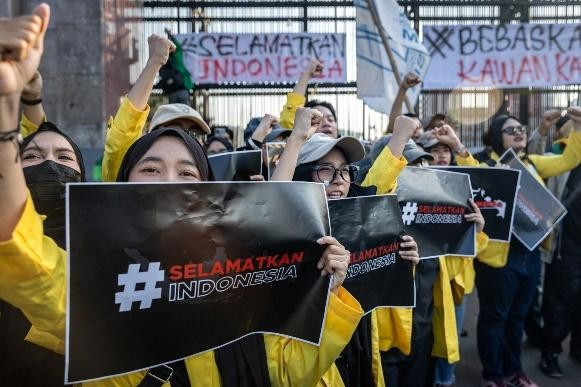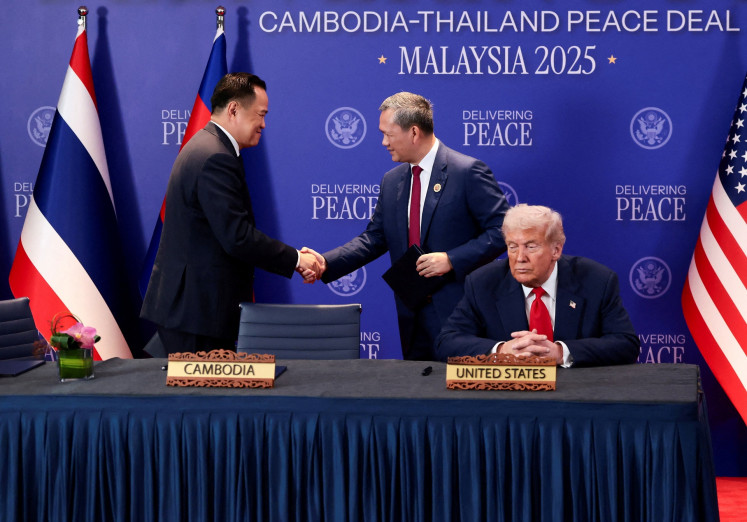Popular Reads
Top Results
Can't find what you're looking for?
View all search resultsPopular Reads
Top Results
Can't find what you're looking for?
View all search resultsChina and ASEAN doing well on economic, trade cooperation
China has been ASEAN’s top trading partner for 10 consecutive years, while ASEAN has been China’s third largest trading partner, after the European Union and the United States, for eight years in a row.
Change text size
Gift Premium Articles
to Anyone
T
he latest data from China’s Customs Administration shows two-way trade between China and ASEAN grew by 14.1 percent to a record US$587.87 billion in 2018, compared to 2017. China has been ASEAN’s top trading partner for 10 consecutive years, while ASEAN has been China’s third largest trading partner, after the European Union and the United States, for eight years in a row.
ASEAN, among China’s top seven trading partners in 2018, and China experienced the fastest growth rate of trade last year. Against the slowdown of global economic growth and the prevalence of trade protectionism, the two-way trade between the two parties continues to maintain a sound momentum and it stands head and shoulders above other major trade relations.
We also note that the gap between China-ASEAN trade volumes and China-US trade volumes narrowed significantly by about 33 percent from $68.9 billion in 2017 to $457 billion in 2018. This only confirms the huge potential and “late-starting advantage” of China-ASEAN trade.
At the same time, as ASEAN’s premier power Indonesia has had increasingly closer trade relations with China. In 2018, Indonesia’s trade with China grew by 22.2 percent to $77.4 billion, the fastest of the 10 ASEAN member states. In particular, sales in China of imports from Indonesia grew significantly to 19.6 percent, a rate only second to the sales in China of imports from Vietnam.
According to the data of China’s Ministry of Commerce, mutual investments continued to increase. In 2018, China’s direct investment flows to ASEAN’s non-financial sectors totaled $9.95 billion, with a year-on-year growth of 5.1 percent, which was faster than the 1.7 percent increase in the previous year. ASEAN investment flows to China were worth $5.72 billion, with a year-on-year growth of 12.5 percent, well above the growth rate of 3.88 percent seen in the previous year.
By the end of 2018, China invested $89.01 billion in ASEAN and ASEAN invested $116.7 billion in China, a 22-fold increase in two-way investment in 15 years, especially as China’s investment in ASEAN accelerated.
The aforementioned data shows that China and ASEAN are not only good neighbors and good friends. China is also one of ASEAN’s most important trade and investment partners and vice versa. China-ASEAN trade relations are in complete harmony.
In 2018, they celebrated the 15th anniversary of the establishment of a strategic partnership. China and ASEAN have joined hands in a new era of greater progress and the relations have developed from a growth stage into a mature stage.
As for the next 15 years, President Xi Jinping has proposed to forge a higher level of China-ASEAN strategic partnership and move toward a closer China-ASEAN community with a shared future, pointing out the main direction for the development of bilateral relations. At the 21st China-ASEAN Summit in November last year the two sides issued the China-ASEAN Strategic Partnership Vision 2030, which laid out medium- and long-term plans for future cooperation.
As Premier Li Keqiang pointed out during the summit, so long as we firmly confirm our confidence in each other’s development, in bilateral cooperation and in the future of East Asia and work closely together to forge ahead, China-ASEAN relations would surely make greater achievements in the next 15 years and benefit the people of all countries in the region.
The rapid development of China-ASEAN economic and trade relations is the result of the joint efforts of governments, enterprises and people from both sides. It can be said our trade relations have got all the advantages.
In 2018, the growth rate of China’s total imports and exports along the “Belt and Road” countries was 13.3 percent, which was higher than that of the China’s overall global trade by 3.6 percent. In the same period, the non-financial direct investment of Chinese enterprises along the “Belt and Road” countries was worth $15.64 billion, with a year-on-year growth rate of 8.9 percent, which is 8.6 percent higher than China’s global investment growth rate.
ASEAN is a key area for jointly building the “Belt and Road” and it was in Indonesia that President Xi proposed the important initiative to build the “21st Century Maritime Silk Road” in 2013. As more and more “Belt and Road” cooperation projects are steadily advancing and bearing fruit in ASEAN countries, the potential of trade cooperation between China and ASEAN under the “Belt and Road” framework would continue to be realized.
It would be a strong impetus for trade and investment on both sides and would benefit more and more enterprises and people in this region in the future. China is going to hold the Second Belt and Road Forum for International Cooperation this year.
Last November, China hosted the first China International Import Expo (CIIE), where President Xi delivered the keynote speech during the opening ceremony. All ASEAN countries sent high-ranking delegations and high-quality companies to attend the expo.
Being the world’s first national-level expo solely for imports, the CIIE demonstrates China’s determination to further open its market to the world. It has also opened a new door for the world’s high-quality goods to enter China’s huge market. It is believed that as the CIIE would be held continually in the future, more and more ASEAN companies would benefit from it.
In addition, multilateral and bilateral free trade arrangements have also boosted China-ASEAN economic and trade exchanges. The upgraded protocol of China-ASEAN Free Trade Agreement took effect on Jan. 1. The new rules of origin are more flexible and convenient in the determination of the origin, which would help companies from both sides enjoy more tariff preferences and promote trade between the two sides.
The negotiations for the Regional Comprehensive Economic Partnership Agreement, joined by both China and ASEAN, are also expected to conclude in 2019. It is believed that the agreement would be a new booster for the development of China-ASEAN economic and trade relations to leap forward.
China is going to hold the second Belt and Road Forum for International Cooperation this year. The Belt and Road Initiative was proposed by China and the results of cooperation are benefiting the whole world.
In the process of promoting international cooperation in the future, we are willing to strengthen strategic synergy with ASEAN on the basis of the following principles: to seek shared benefits through consultation and collaboration; to ensure transparency, openness and tolerance and abide by international laws and international norms, to promote cooperation projects adhering to high standards, high quality and high levels and to establish financial, environmental and ecological sustainability.
It is believed that cooperation between the two sides would continue to deepen and bear more fruit, while the sustainability of development would be enhanced.
***
The writer is Chinese ambassador to ASEAN.










